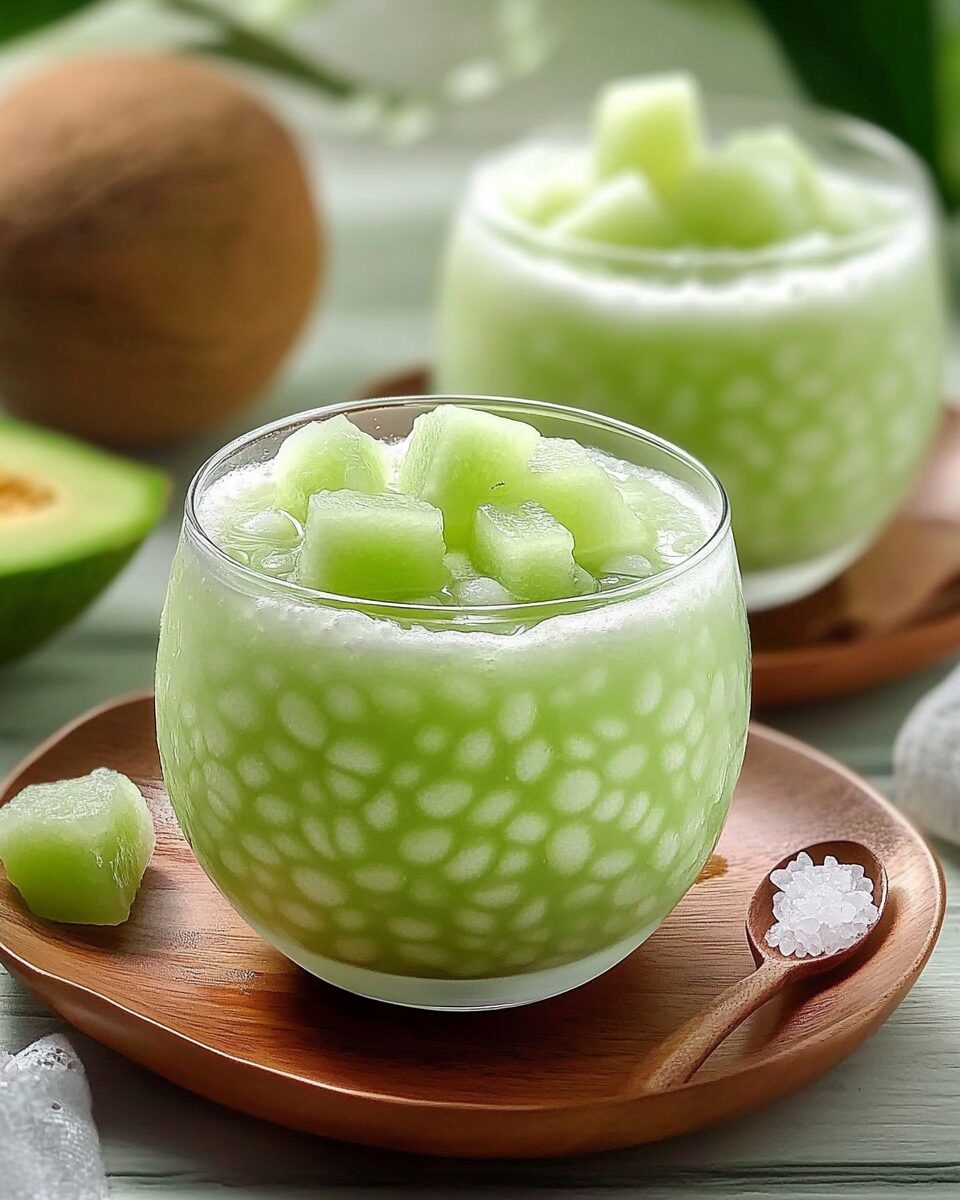Honeydew Sago is a refreshing and creamy tapioca pudding made with juicy honeydew melon and rich coconut milk. This chilled Asian-inspired dessert is light, naturally sweet, and perfect for hot weather. With its smooth texture and fruity flavor, it’s a simple yet elegant treat that’s popular in many Southeast Asian cuisines.
Full Recipe:
Ingredients
-
½ cup small tapioca pearls
-
2 cups water (for cooking tapioca)
-
½ honeydew melon, pureed or finely chopped
-
1½ cups coconut milk
-
¼ cup sweetened condensed milk (adjust to taste)
-
1–2 tablespoons sugar (optional, to adjust sweetness)
-
Ice cubes or crushed ice (optional, for serving)
Directions
-
Cook Tapioca Pearls:
Bring 2 cups of water to a boil. Add tapioca pearls and simmer for about 15 minutes, stirring occasionally. Remove from heat and let sit covered for 10–15 minutes until translucent. Rinse under cold water and drain well. -
Prepare Honeydew:
Cut the honeydew in half. Scoop out and discard seeds. Puree one half or finely chop it, depending on desired texture. -
Mix Dessert:
In a large bowl, combine cooked tapioca, coconut milk, honeydew puree, and condensed milk. Mix well. Taste and add sugar if needed. -
Chill:
Refrigerate for 1–2 hours until well chilled. -
Serve:
Spoon into bowls or glasses. Optionally, add crushed ice for an extra refreshing touch.
Nutrients (Approximate per serving, based on 4 servings)
-
Calories: ~250–300 kcal
-
Protein: ~2g
-
Fat: ~10–12g
-
Carbohydrates: ~35–40g
-
Sugar: ~18–22g
-
Fiber: ~1g
The Origins and Cultural Significance
Sago-based desserts like this one have a long history throughout many parts of Asia, particularly in countries such as Malaysia, Singapore, Thailand, and the Philippines. Tapioca pearls, derived from cassava starch, have been used for centuries to create desserts and beverages, prized for their delightful chewiness and ability to absorb surrounding flavors.
Honeydew Sago is a beautiful example of how traditional ingredients combine with local fruits and coconut milk to create something fresh and vibrant. This dessert embodies the balance of sweetness, creaminess, and texture so characteristic of Southeast Asian cuisine. It’s a staple at street markets and family tables alike, cherished for its simple preparation and satisfying flavor profile.
Key Ingredients and Their Role
The magic of Honeydew Sago lies in its simple but carefully chosen ingredients. The tapioca pearls provide a chewy, slightly gelatinous texture that contrasts perfectly with the smoothness of the coconut milk and the juiciness of the honeydew melon. Cooking the pearls properly until translucent ensures the right balance of softness and chew, making each spoonful enjoyable.
Honeydew melon, with its subtly sweet, fragrant flesh, adds natural sweetness and a fresh fruity note. Using fresh, ripe honeydew is essential for optimal flavor. You can choose to puree the melon for a silky, smooth dessert or finely chop it if you prefer bursts of juicy texture throughout.
The coconut milk brings a rich, tropical creaminess that rounds out the dish and gives it a luscious mouthfeel. Its natural fats contribute to the dessert’s richness without overwhelming the lightness imparted by the melon.
Sweetened condensed milk is often added to introduce a creamy sweetness that enhances the natural sugars of the fruit. It’s easy to adjust the amount to suit personal preferences, making this dessert flexible in sweetness levels.
Preparation and Serving
One of the great advantages of Honeydew Sago is its relatively quick and straightforward preparation. While the tapioca pearls require some attention during cooking to ensure they become translucent and chewy without sticking together, the rest of the assembly is simple—mixing cooked pearls with coconut milk, honeydew, and sweeteners, then chilling until perfectly cool.
Chilling the dessert for at least an hour allows the flavors to meld and the texture to become even more harmonious. For those seeking an extra refreshing touch, adding crushed ice or ice cubes at serving time intensifies the cool, tropical vibe of the dessert—ideal for warm weather or outdoor dining.
Honeydew Sago can be served in elegant glasses for a refined presentation or in bowls for casual family-style enjoyment, making it versatile for any occasion.
Texture and Flavor Harmony
What makes this dessert stand out is the interplay of textures and flavors. The chewy tapioca pearls provide a fun contrast to the silky coconut milk and the juicy, tender honeydew pieces. Each spoonful is a delightful blend of creamy, sweet, and slightly chewy elements that satisfy multiple sensory cravings.
The sweetness is balanced—not overly sugary but just enough to highlight the honeydew’s natural flavor. The coconut milk’s richness tempers the fruit’s brightness, creating a well-rounded and soothing dessert that feels indulgent without heaviness.
Nutritional Benefits
While Honeydew Sago is undoubtedly a treat, it also offers some nutritional positives. Honeydew melon is rich in vitamins C and A, both powerful antioxidants that support immune health and skin vitality. It’s also hydrating and low in calories, making it an excellent choice for a refreshing dessert.
Coconut milk contributes healthy fats, primarily medium-chain triglycerides (MCTs), which are linked to improved energy metabolism. Tapioca pearls, while primarily a source of carbohydrates, provide gluten-free starch and some fiber depending on preparation.
The dessert contains moderate amounts of sugar, mostly from the condensed milk and natural fruit sugars, so adjusting sweetness to taste allows for more mindful eating. Overall, this dish offers hydration, energy, and a dose of tropical flavor packed into every spoonful.
Cultural and Seasonal Appeal
In tropical and subtropical climates where Southeast Asian cuisines flourish, Honeydew Sago is more than a dessert—it’s a symbol of refreshment and hospitality. Served during family celebrations, religious festivals, or simply as a daily treat, it reflects the region’s emphasis on fresh, natural ingredients and balanced flavors.
Seasonally, Honeydew Sago shines best when melons are in peak freshness and sweetness, typically during warmer months. This makes it a perfect summer dessert, helping to cool the body while providing gentle nourishment.
Variations and Customizations
While the classic recipe centers on honeydew melon, many variations exist that incorporate other tropical fruits such as mango, cantaloupe, or lychee, allowing for a vibrant medley of flavors and colors. Some recipes also include small tapioca pearls mixed with larger ones for varied texture.
For those seeking to reduce sugar, the condensed milk can be replaced with coconut sugar syrup or agave nectar, though this may alter the creaminess slightly. Additionally, swapping coconut milk for almond or soy milk creates different flavor nuances suitable for varying dietary preferences.
For an even more luxurious dessert, some versions add a splash of pandan extract or top with toasted coconut flakes and fresh mint leaves, enhancing aroma and presentation.
Pairing and Serving Suggestions
Honeydew Sago is best enjoyed chilled on its own or alongside light complementary dishes. It pairs beautifully with jasmine or green tea, which accentuate its fresh, herbal notes without overpowering the delicate sweetness.
Serving in small portions as a refreshing palate cleanser after a spicy or heavy meal can elevate dining experiences. It’s also perfect for outdoor picnics, brunch buffets, or as a crowd-pleaser dessert for warm weather gatherings.
Conclusion
Honeydew Sago is a timeless Asian dessert that perfectly balances refreshment, creaminess, and natural sweetness. Its delicate texture, vibrant flavor, and elegant presentation make it a versatile dish loved across cultures and generations. This chilled tapioca pudding embodies the essence of tropical comfort food—light yet indulgent, simple yet sophisticated.
Whether you’re looking to cool down on a hot day, impress guests with a beautiful and flavorful dessert, or enjoy a nourishing snack, Honeydew Sago delivers a sensory delight that is both satisfying and uplifting. Easy to prepare yet rich in tradition and taste, it’s a wonderful addition to any culinary repertoire and a celebration of the beautiful flavors of Southeast Asia.

